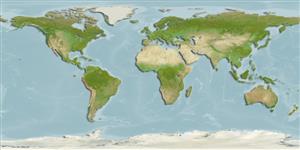Preferred temperature (Ref.
123201): 18.5 - 24.8, mean 21 °C (based on 150 cells).
Phylogenetic diversity index (Ref.
82804): PD
50 = 0.5156 [Uniqueness, from 0.5 = low to 2.0 = high].
Bayesian length-weight: a=0.01995 (0.00906 - 0.04395), b=3.01 (2.83 - 3.19), in cm total length, based on all LWR estimates for this body shape (Ref.
93245).
Niveau trophique (Ref.
69278): 3.9 ±0.2 se; based on diet studies.
Résilience (Ref.
120179): Faible, temps minimum de doublement de population : 4,5 à 14 années (tmax assumed to be > 10).
Fishing Vulnerability (Ref.
59153): Moderate to high vulnerability (46 of 100).
Nutrients (Ref.
124155): Calcium = 35.8 [18.4, 59.5] mg/100g; Iron = 0.507 [0.296, 0.799] mg/100g; Protein = 19.1 [18.0, 20.2] %; Omega3 = 0.0995 [, ] g/100g; Selenium = 35.3 [20.7, 63.4] μg/100g; VitaminA = 38.2 [11.5, 122.6] μg/100g; Zinc = 0.811 [0.567, 1.171] mg/100g (wet weight);
